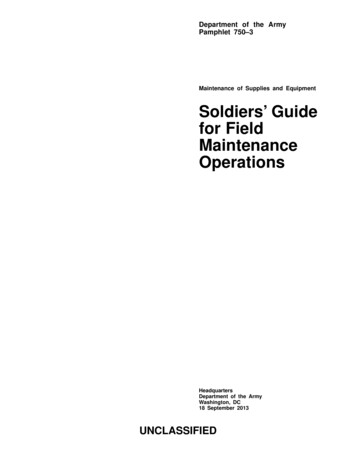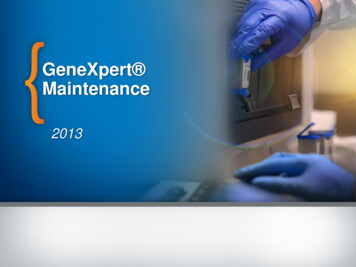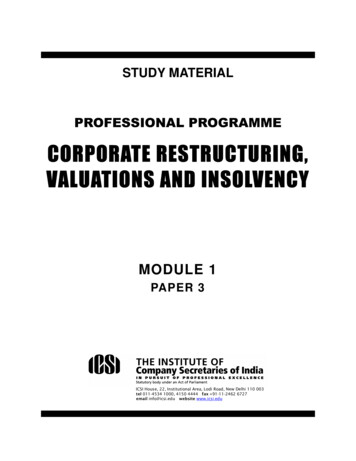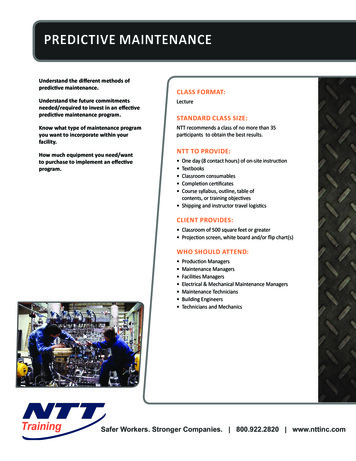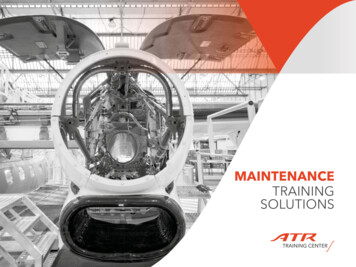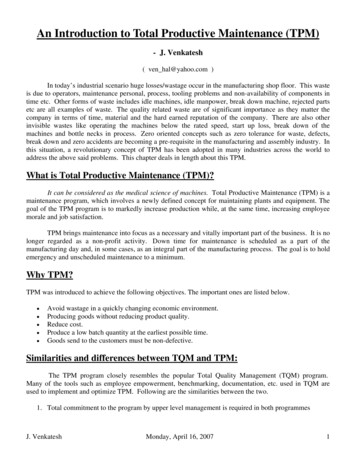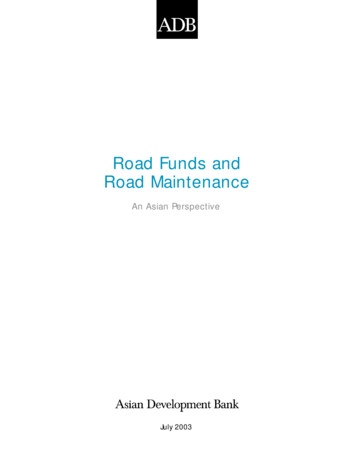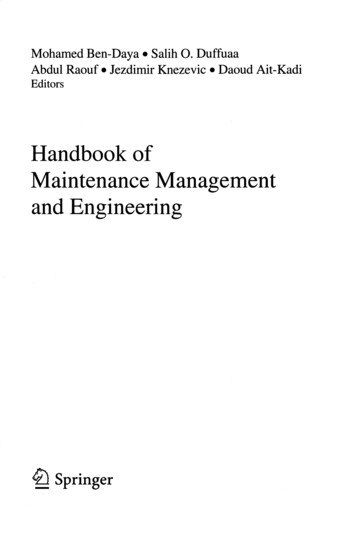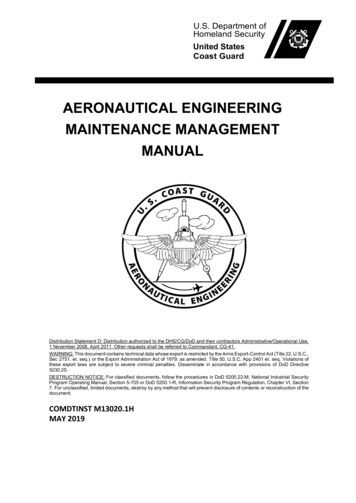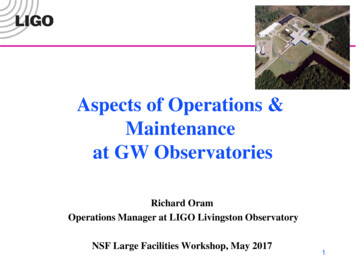
Transcription
Aspects of Operations &Maintenanceat GW ObservatoriesRichard OramOperations Manager at LIGO Livingston ObservatoryNSF Large Facilities Workshop, May 2017LIGO-G1500239-v11
LIGO Laboratory: two observatories,Caltech and MIT campuseslllMission: to develop gravitational-wave detectors, and to operatethem as astrophysical observatoriesJointly managed by Caltech and MIT; responsible for operatingLIGO Hanford and Livingston ObservatoriesRequires instrument science at the frontiers of physicsfundamental limitsMITCaltechLIGO Livingston2LIGO-G1500239-v1
LIGO Laboratory’sOverall Mission Advanced LIGO Detectors – commission the newly constructedAdvanced LIGO to design sensitivity Physics/Astrophysics Research - direct detection of gravitational wavesand development and exploitation of gravitational-wave astronomy Precision Interferometry Research – research and development toupgrade and improve Advanced LIGO detectors Facilities - operate and maintain the LIGO Observatories and campusfacilities Education and Public Outreach – develop scientific education andpublic outreach related to gravitational wave astronomy Develop the Global network – develop the international gravitationalwave community to coordinate gravitational wave observations;support the construction of LIGO-India(Condensed from the LIGO Lab Charter)3LIGO-G1500239-v1
Operation and MaintenanceThe LIGO detector must run 7x24 during runs (since Nature cansend events at any time O&M of Advanced LIGO detector, incremental sensitivityand robustness improvements.LVEA Roof Completed O&M Site and Facility and Vacuumequipment maintenance (now 20 yrs. old)Some Major Facility Lifecycle Renewalscompleted ahead of O1. Re-roofing of Twelve original roofs &reinstall lightning protection- CompletedFeb 2014 as specified with a 20 yearwarranty Renew original Main and End stationchillers: 6 new & 1 refurbishedCompleted Feb 2014LIGO-G1500239-v1Main Chiller#1 & #2 installed
Observatory Sites overview Sites: LHO:1500 acres, LLO:180 acres. Erosion control, flood control, grass, tumbleweed mowing/abatement. Access control/ security.(LLO 16km of border with forestry & hunters) 13 miles of paved access roads. Facility: Potable water supplies and sewerage; treatment, testing and permitting. Fire water storage, distribution, pumps, hydrants, sprinklers maintainedto code. Fire control systems within buildings, including clean agentsystems for critical electronics and computers. 13.6 kV 3-phase power distribution to 480 V 3-phase panels, specialbalanced 117 V technical power for detector electronics. Clean room lab areas, with HEPA-filtered air and contamination controlprotocols, precise temperature and humidity control, special low-vibrationHVAC fans, remote chillers and plenum space to reduce temperaturegradients, overhead cranes, fork lift trucks, aerial lifts, etc. Office space, auditorium for collaboration and outreach meetings. Need to maintain facilities anticipating 20 more years of operation.LIGO-G1500239-v1
Threat/ Disaster ManagementEnvironmental Threats that affect sites and staff: LIGO Livingston: Hurricanes, tornadoes, heavy rain, flooding,lightning, high humidity, heat stress management, critters . LIGO Hanford: Snow, icy roads, extreme cold, extreme heat,scrub fires, tumbleweeds, critters Lesson learned: Have a plan and fit in with what the communitydoes. For example, when New Orleans is likely to evacuate,normal commerce and transportation is impossible in theLivingston area, so we close our gate valves and evacuatethe site. This must be done days before a hurricane landfall.LIGO-G1500239-v1
Property Lifecycle Maintenance Plan:Asset Condition Report LIGO M&O Cooperative Support Agreement (CSA) for FY2014FY2018 “Subject to the availability of funding, the Awardee will provide by October 1, 2016an Asset Condition Report evaluating the remaining life of civil infrastructure at theLHO and LLO sites, and estimating the cost of significant replacement orrefurbishment to be scheduled during Oct 1, 2018 - Sept 30, 2023.” In response LIGO selected a consulting civil engineering firm (1VFAinc., part of Accruent LLC.) and completed a condition assessment ofthe sites and provide staff training during July 2016. The data from this assessment are now entered into web basedVFA.auditor and will be used for future maintenance management,capital planning & budgeting and report generation.1VFA,Inc (an accruent company)- http://www.vfa.com/7LIGO-G1500239-v1LIGO Laboratory
Property Lifecycle Maintenance PlanPlan Development The VFA assessment team consisting of an architectural, mechanical, and anelectrical consultant performed assessment inspections of 26 buildings andassociated assets (13 buildings each at LLO and LHO). The VFA assessment team used the ASTM standard (E1557-09 (2015))Uniformat II Classification for Building Elements- classifying buildingspecifications, cost estimating, and cost analysis. The elements are majorcomponents common to most buildings. Uniformat estimating applies unit-cost data to building-system and component siteelements. This “systems” approach uses a hierarchical structure of cost elements,beginning at Level 1 with basic systems, such as Substructure, Exterior Enclosure,and Interior Construction, and proceeding to successively more detailed subdivisionsof these systems at Levels 2-5. See GSA.gov.- Uniformat. Estimates for Systems and Requirement Actions were made using RSMeans tablesfor 2016. RSMeans supplies construction cost information for North America usedto estimate the costs of construction and renovation projects. For more informationon RSMeans, go to www.rsmeans.com.8LIGO-G1500239-v1LIGO Laboratory
Property Lifecycle Maintenance PlanVFA Facility and FacilityViewLIGO-G1500239-v1
The Facility Condition Index (FCI) The Facility Condition Index (FCI), a standard used to indicate the condition ofan asset or assets, is the ratio of the cost of requirements divided by the currentreplacement value (CRV) of the asset. The CRV is the total value of all systemsthat make up a particular asset. The lower the FCI value the better thecondition of the building or asset. The FCI is calculated as:FCI Total FCI RequirementsCurrent Replacement Value FCI calculations result in the determination that each asset or assets fall intothe qualitative description of excellent, good, fair or poor. The lower the FCIvalue the better the condition of the building.10LIGO-G1500239-v1LIGO Laboratory
Property Lifecycle Maintenance PlanVFA Facility and FacilityViewLIGO-G1500239-v1
Property Lifecycle Maintenance PlanVFA Facility and FacilityViewLIGO-G1500239-v1
Property Lifecycle Maintenance Plan FY2019 – 2023Total of 339 Requirements/Renewals over Five years. A Requirement is a facility need or a deficient condition that should be addressed, including deferredmaintenance, code issues, functional requirements, and capital improvements.Requirement records are created underneath the Asset where the condition occurs. Each Requirementhas an Action, which is a remedy for the condition that includes itemized cost estimates.Distribution by ASTM standard(E1557-09 (2015)) Uniformat IIClassification for Building Elements13LIGO-G1500239-v1LIGO Laboratory
Property Lifecycle Maintenance Plan:Peer Review NSF review recommendation:» “Have the Property Life Cycle Maintenance Plan peer reviewedand vetted by maintenance professionals from a similar largescience facility (e.g. JPL, Fermilab, etc.) annually.” We now include Lifecycle maint. section in LIGO’sAnnual Work Plan:» The property lifecycle plan is a list of planned activities andbudgetary estimates for accomplishing maintenance activities.» LIGO is now conducting this peer review activity withappropriate external reviewers from ESO, Fermilab andSmithsonian facilities.14LIGO-G1500239-v1
Some unique aspects of maintenance@ GW ObservatoriesAlways being conscious of need to be quiet in the work that we do. Site maintenance activities and equipment adjusted for minimum disturbance(vibration and E/M interference).Weekly Preventive Maintenance squeezed into a Four hour periodevery Tuesday 9 am – 1 pm. (LLO and LHO nearly coincident) Use of CMMS (FAMIS) to organize and schedule Tuesday PMs Contractors provide service and regular maintenance during 4hour/week period. Rigorous use of work permit process to communicate, approveand de-conflict non-routine workLIGO-specific considerations: LIGO Lab members are part of the LIGO Scientific Collaboration, so we are partof our user community. Various LSC members contribute to O&M. GW science greatly rewards even small range improvements, so steady-stateoperation often includes incremental improvements.LIGO-G1500239-v1
Improved Operational Processes:Computerized Maintenance Management System (CMMS) Computerized Maintenance Management: Preventative Maintenance: planned and organized using FAMIS cloud based CMMS Corrective Maintenance, Integration issues: reported and tracked using customizedbugzilla software, locally called FRS (Fault Reporting System). Software bugs/featurestracked with bugzilla instances. “Process Flow for Engineering Operations of the LIGO Detector Systems”.» Rigorous use of work permit process to communicate, approve and de-conflict non-routine work Spares procurement and planning.» Non-detector (infrastructure) spares to be tracked in FAMIS.» Detector spares tracked using aLIGO-developed Inventory Control System ICS. Performance monitoring and reaction: Key performance indicator “dashboard.” In weekly reviews, recurring faults are noted and receive additional analysis, as arefaults that cause significant downtime. Facility Asset Condition Report completed. Property life-cycle maintenance plan, budgets and tasks for maintenance, now16formally part of annual work plan:LIGO-G1500239-v1
Computerized Maintenance Management SystemOperations Management Team: Bug 33 - OMT charge to implement maintenance database services for both Observatories Corrective Maintenance (FRS): In progress: Daily use of the Fault Reporting System (FRS) toimprove response time and quality of service provided to fault reports and service requests.Operations groups now daily use operational data (from aLOG, FRS, Work Permits) to prioritizeand schedule daily/weekly work plans and drive decisions.LHO/LLO roll out of FRS 2.0combined FRS & IntegrationIssues & ECR Tracker : TheCMMS team members alongwith LIGO SystemsEngineering have definedrequirements (FRS 2.0 user'smanual: T1400332) for aunified implementation of theFRS (for both observatories)together with the functionalityof the aLIGO integration issuestrackerLIGO-G1500239-v1LLO Facilities, GC and Admin issueswere added to CDS in 2013.The remaining Operations FunctionalGroups were added in May 2014 @ LLOand June 2015 @LHOLIGO LaboratoryUpto Mid-April 2017 17
Activity: Operations use of FRSKey Performance ink to Weekly Key Performance Indicator Dashboard isLIGO .caltech.edu/KPI18
Observatory OperationsObserving time scheduled into Observing blocks - O1, O2, O3 etc.punctuated by Commissioning periods, Planned Engineering andEngineering Runs ( month)aLIGO Observing runs.O1 4 months,O2 6 monthsO3 12 monthsControl room is staffed 24/7 by “on-duty operator”during observing runs to monitor and operate detector,maximize uptime and provide safety.Weekday support and then overnight and weekend “On-call” by team of Detector Engs,Scientists, SWE, EE, Facility and Vacuum Eng. and Managers.Observatory operations hinge upon the goodwill andprofessionalism of the amazingly dedicated staff.Staff assignments are adjusted, and family life altered to operate detector as reliablyas possible.LIGO-G1500239-v1
A large number of functions, resources and tools,organized by specialized teams20LIGO-G1500239-v1LIGO-G1601236-v3
O1 Performance: Observing summaryO1, which began at 10:00 am CT on September 18th, 2015. O1 ran for 16 weeks and 4 days and ended January 12th2016 at 10:00 am CT. LLO L1 cumulative uptime was 57.3 %., LHO H1 cumulative uptime was 64.6 %., Operators tracked status duringrun, observing, locking, excessenvironmental noise,commissioning, maintenance,planned engineering, etc. Winter run included expectedhigh ground motion and stormsNo evident trends. 21LIGO-G1601236-v3LIGO-G1500239-v1
LLO O1 Performance:Observing summaryO1 L1 cumulative uptime was 57.3 %; Observing Time Loss due to HW/SW/Proceduralfaults was 120.8 hrs ( 4.3 %)O1(18/09/2015-12/01/2016)- 16 weeks and four days22LIGO-G1500239-v1
LLO O1 Performance:Observing summary O1, which began at 10:00 am CT on September 18th, 2015 ran for 16 weeks and 4 days (2784 hours) andended January 12th 2016 at 10:00 am CT. The LLO L1 cumulative uptime was 57.36 %.Obs igningPreventive MaintenanceCommissioningCalibrationCorrective MaintenancePower GlitchUnknownGrand TotalDuration :4237:4433:1717:031:502783:59LIGO 6%2.25%1.61%1.36%1.20%0.61%0.07%100.00% Corrective Maint. is underreported on this table since in“realtime” the on-dutyoperators manually selects“Acquiring” state until thefault condition is recognized. A follow-up review of thefaults by Detector Eng.corrected this to around 4.3%23
O1 Performance:Detector Engineering Operations & Maintenance: O1, which began at 10:00 am CTon September 18th, 2015. O1 ran for 16 weeks and 4 days and ended January 12th2016 at 10:00 am CT.The L1 and H1 detectors achieved an NS-NS inspiral range of 60-80 Mpc duringO1; No major Commissioning breaks or interventions were necessary.LLO L1 cumulative uptime was 57.3 %., LHO H1 cumulative uptime was 64.6 %.Double Interferometer cumulative uptime was 42.8 %.LLO:Observing Time Loss due to HW/SW/Procedural faults was 120.8 hrs ( 4.3 %).Opportunities for Improving Observing uptime 60%: (Any low hanging fruit ?) Better strategies for maximizing coincident observing. (PMs, no risky WP) Streamlining “acquiring process” ( 10%) Wind and microseism remediation ( 12%) (somewhat seasonal, run planning?) Power glitches ( 1%)24LIGO-G1500239-v1
O1 & O2 Performance: Observing summaryO1O2 still in progressO1, which began at 10:00 am CT on September 18th,2015. O1 ran for 16 weeks and 4 days and endedJanuary 12th 2016 at 10:00 am CT. DoubleInterferometer cumulative uptime was 42.8 %.O2 commenced 10:00 am CT Nov 30th 2016. As ofFriday April 28th 2017, (21 weeks or 3270 hours)into O2, Double Interferometer cumulative uptime isaround 52.1%.Duty FactorPlanned breakTotal Observing Time25LIGO-G1500239-v1
O1 & O2 Performance: Observing summaryO1 The L1 & H1 detector achieved a NS-NSinspiral range of 60-80 Mpc during O1O2 still in progress The L1 & H1 detector achieved a NS-NSinspiral range of 65-95 Mpc during O2Planned breakRough online calibration /- 10%Planned breakRangeLIGO-G1500239-v1ObservingUptime
LIGO O2 Operational State and ModeOperator-reportedTop-level modes:Causes of state.LIGO-G1500239-v1Planned breakLivingston O2 commenced 10:00 am CT Nov 30th 2016. As ofFriday, (21 weeks) into O2, Overall L1 operations hasachieved a cumulative uptime of around 63.3%. This performance is a little better than expectedperformance of 60% and the trend is improving. The main cause of down time are environmental,locking, preventive maintenance, commissioningtime and faults that required corrective maintenance.
Conclusion LIGO’s Operation and Maintenance has been informed by 20years of observatory site activities, together with robust Labwide engineering, systems, business and managerial support. The Advanced LIGO Project provided a firm foundation ofchange control, documentation, issue tracking, etc., thatremain in use. We are implementing several modern managerial systems,including computerized maintenance management, trackingperformance indicators, quantitative long-term maintenanceplanning, etc. The first observational run O1, and the demands place onoperations from the detection, were handled successfully. We are 21 weeks into O2, which is proceeding well. Manythanks to the amazingly dedicated staff.28LIGO-G1500239-v1
We are 21 weeks into O2, which isproceeding well. Many thanks to theamazingly dedicated staff.Thankyou!29LIGO-G1500239-v1
Round Table Discussion oncommon challenges to LF O&M30LIGO-G1500239-v1
Common communication challenges31LIGO-G1500239-v1
Common budget challenges32LIGO-G1500239-v1
Common lifecycle challenges33LIGO-G1500239-v1
Common HR challenges34LIGO-G1500239-v1
Common Planning challenges35LIGO-G1500239-v1
Common external challenges36LIGO-G1500239-v1
for 2016. RSMeans supplies construction cost information for North America used to estimate the costs of construction and renovation projects. For more information on RSMeans, go to www.rsmeans.com.
